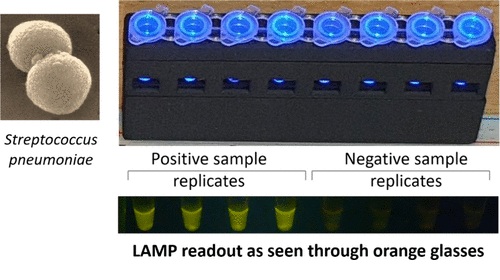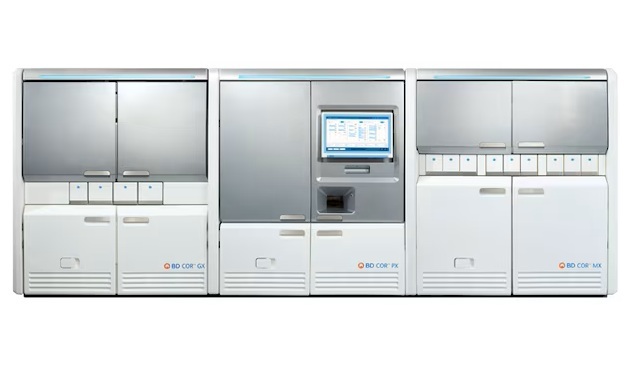Hybrid Protein Developed as Tools for Gene Cutting, Editing
|
By LabMedica International staff writers Posted on 23 Sep 2010 |
A U.S. team of researchers has developed a kind of hybrid proteins that can make double-strand DNA breaks at specific sites in living cells, potentially leading to better gene replacement and gene editing therapies.
Dr. Bing Yang, assistant professor of genetics, development and cell biology at Iowa State University (ISU; Ames, USA;), and his colleagues developed the hybrid protein by joining parts of two different bacterial proteins. One is called a TAL (transcription activator-like) effector, which functions to find the specific site on the gene that needs to be cut, and the other is an enzyme called a nuclease that cuts the DNA strands. Dr. Yang hopes this study will lead to the ability to engineer genomes by cutting out defective or undesirable parts of DNA, or by replacing defective or undesirable gene segments with a functioning piece of replacement DNA--a process called homologous recombination.
Dr. Yang reported that these hybrid proteins could be constructed to locate specific segments of the DNA in any sort of organism. "This breakthrough could eventually make it possible to efficiently modify plant, animal and even human genomes,” said Dr. Yang. "It should be effective in a range of organisms.”
The proteins function by binding onto the specific segment of DNA the researcher needs to change. These proteins do this by reading the DNA sequence and finding the specific area to be cut. Once the protein binds onto the DNA at the correct spot, the other half of the protein then cuts the double-stranded DNA. Bad or undesirable DNA can be resected and good or more desirable DNA can be introduced. When the DNA heals, the good DNA is included in the gene.
Dr. Yang began his project approximately one year ago after seeing the results of research by Dr. Adam Bogdanove, ISU associate professor of plant pathology, showing that TAL effectors use a very clear-cut code to bind to a specific DNA sequence. This discovery allowed Dr. Yang to predict precisely where the TAL effector nuclease will bind on the DNA to make the cut. Another study had similar results.
The conecept has also been validated by Dr. Bogdanove and Dr. Dan Voytas, collaborator in genetics, development, and cell biology at Iowa State, and director of the Center for Genome Engineering at the University of Minnesota (Twin Cities, USA). The TAL effector-nuclease approach improves on tools currently available for genome modification. It should be faster and less expensive to make TAL effector nucleases, and simpler to design them to recognize specific DNA sequences, according to Dr. Yang.
Yang's findings appeared in August 2010 in the online version of the journal Nucleic Acids Research. Dr. Voytas' and Bogdanove's study also appeared in August 2010 the journal Genetics. Dr. Voytas and Dr. Bogdanove were also able to demonstrate that the TAL effector part of the hybrid protein can be modified to target new DNA sequences.
Related Links:
Iowa State University
Dr. Bing Yang, assistant professor of genetics, development and cell biology at Iowa State University (ISU; Ames, USA;), and his colleagues developed the hybrid protein by joining parts of two different bacterial proteins. One is called a TAL (transcription activator-like) effector, which functions to find the specific site on the gene that needs to be cut, and the other is an enzyme called a nuclease that cuts the DNA strands. Dr. Yang hopes this study will lead to the ability to engineer genomes by cutting out defective or undesirable parts of DNA, or by replacing defective or undesirable gene segments with a functioning piece of replacement DNA--a process called homologous recombination.
Dr. Yang reported that these hybrid proteins could be constructed to locate specific segments of the DNA in any sort of organism. "This breakthrough could eventually make it possible to efficiently modify plant, animal and even human genomes,” said Dr. Yang. "It should be effective in a range of organisms.”
The proteins function by binding onto the specific segment of DNA the researcher needs to change. These proteins do this by reading the DNA sequence and finding the specific area to be cut. Once the protein binds onto the DNA at the correct spot, the other half of the protein then cuts the double-stranded DNA. Bad or undesirable DNA can be resected and good or more desirable DNA can be introduced. When the DNA heals, the good DNA is included in the gene.
Dr. Yang began his project approximately one year ago after seeing the results of research by Dr. Adam Bogdanove, ISU associate professor of plant pathology, showing that TAL effectors use a very clear-cut code to bind to a specific DNA sequence. This discovery allowed Dr. Yang to predict precisely where the TAL effector nuclease will bind on the DNA to make the cut. Another study had similar results.
The conecept has also been validated by Dr. Bogdanove and Dr. Dan Voytas, collaborator in genetics, development, and cell biology at Iowa State, and director of the Center for Genome Engineering at the University of Minnesota (Twin Cities, USA). The TAL effector-nuclease approach improves on tools currently available for genome modification. It should be faster and less expensive to make TAL effector nucleases, and simpler to design them to recognize specific DNA sequences, according to Dr. Yang.
Yang's findings appeared in August 2010 in the online version of the journal Nucleic Acids Research. Dr. Voytas' and Bogdanove's study also appeared in August 2010 the journal Genetics. Dr. Voytas and Dr. Bogdanove were also able to demonstrate that the TAL effector part of the hybrid protein can be modified to target new DNA sequences.
Related Links:
Iowa State University
Latest BioResearch News
- Genome Analysis Predicts Likelihood of Neurodisability in Oxygen-Deprived Newborns
- Gene Panel Predicts Disease Progession for Patients with B-cell Lymphoma
- New Method Simplifies Preparation of Tumor Genomic DNA Libraries
- New Tool Developed for Diagnosis of Chronic HBV Infection
- Panel of Genetic Loci Accurately Predicts Risk of Developing Gout
- Disrupted TGFB Signaling Linked to Increased Cancer-Related Bacteria
- Gene Fusion Protein Proposed as Prostate Cancer Biomarker
- NIV Test to Diagnose and Monitor Vascular Complications in Diabetes
- Semen Exosome MicroRNA Proves Biomarker for Prostate Cancer
- Genetic Loci Link Plasma Lipid Levels to CVD Risk
- Newly Identified Gene Network Aids in Early Diagnosis of Autism Spectrum Disorder
- Link Confirmed between Living in Poverty and Developing Diseases
- Genomic Study Identifies Kidney Disease Loci in Type I Diabetes Patients
- Liquid Biopsy More Effective for Analyzing Tumor Drug Resistance Mutations
- New Liquid Biopsy Assay Reveals Host-Pathogen Interactions
- Method Developed for Enriching Trophoblast Population in Samples
Channels
Clinical Chemistry
view channel
VOCs Show Promise for Early Multi-Cancer Detection
Early cancer detection is critical to improving survival rates, but most current screening methods focus on individual cancer types and often involve invasive procedures. This makes it difficult to identify... Read more
Portable Raman Spectroscopy Offers Cost-Effective Kidney Disease Diagnosis at POC
Kidney disease is typically diagnosed through blood or urine tests, often when patients present with symptoms such as blood in urine, shortness of breath, or weight loss. While these tests are common,... Read moreMolecular Diagnostics
view channel
New Diagnostic Method Detects Pneumonia at POC in Low-Resource Settings
Pneumonia continues to be one of the leading causes of death in low- and middle-income countries, where limited access to advanced laboratory infrastructure hampers early and accurate diagnosis.... Read more
Blood Immune Cell Analysis Detects Parkinson’s Before Symptoms Appear
Early diagnosis of Parkinson’s disease remains one of the greatest challenges in neurology. The condition, which affects nearly 12 million people globally, is typically identified only after significant... Read moreHematology
view channel
ADLM’s New Coagulation Testing Guidance to Improve Care for Patients on Blood Thinners
Direct oral anticoagulants (DOACs) are one of the most common types of blood thinners. Patients take them to prevent a host of complications that could arise from blood clotting, including stroke, deep... Read more
Viscoelastic Testing Could Improve Treatment of Maternal Hemorrhage
Postpartum hemorrhage, severe bleeding after childbirth, remains one of the leading causes of maternal mortality worldwide, yet many of these deaths are preventable. Standard care can be hindered by delays... Read more
Pioneering Model Measures Radiation Exposure in Blood for Precise Cancer Treatments
Scientists have long focused on protecting organs near tumors during radiotherapy, but blood — a vital, circulating tissue — has largely been excluded from dose calculations. Each blood cell passing through... Read moreImmunology
view channel
Blood-Based Liquid Biopsy Model Analyzes Immunotherapy Effectiveness
Immunotherapy has revolutionized cancer care by harnessing the immune system to fight tumors, yet predicting who will benefit remains a major challenge. Many patients undergo costly and taxing treatment... Read more
Signature Genes Predict T-Cell Expansion in Cancer Immunotherapy
Modern cancer immunotherapies rely on the ability of CD8⁺ T cells to rapidly multiply within tumors, generating the immune force needed to eliminate cancer cells. However, the biological triggers behind... Read moreMicrobiology
view channel
High-Throughput Enteric Panels Detect Multiple GI Bacterial Infections from Single Stool Swab Sample
Gastrointestinal (GI) infections are among the most common causes of illness worldwide, leading to over 1.7 million deaths annually and placing a heavy burden on healthcare systems. Conventional diagnostic... Read more
Fast Noninvasive Bedside Test Uses Sugar Fingerprint to Detect Fungal Infections
Candida bloodstream infections are a growing global health threat, causing an estimated 6 million cases and 3.8 million deaths annually. Hospitals are particularly vulnerable, as weakened patients after... Read morePathology
view channel
New Molecular Analysis Tool to Improve Disease Diagnosis
Accurately distinguishing between similar biomolecules such as proteins is vital for biomedical research and diagnostics, yet existing analytical tools often fail to detect subtle structural or compositional... Read more
Tears Offer Noninvasive Alternative for Diagnosing Neurodegenerative Diseases
Diagnosing and monitoring eye and neurodegenerative diseases often requires invasive procedures to access ocular fluids. Ocular fluids like aqueous humor and vitreous humor contain valuable molecular information... Read moreTechnology
view channel
Cell-Sorting Device Uses Electromagnetic Levitation to Precisely Direct Cell Movement
Sorting different cell types—such as cancerous versus healthy or live versus dead cells—is a critical task in biology and medicine. However, conventional methods often require labeling, chemical exposure,... Read more
Embedded GPU Platform Enables Rapid Blood Profiling for POC Diagnostics
Blood tests remain a cornerstone of medical diagnostics, but traditional imaging and analysis methods can be slow, costly, and reliant on dyes or contrast agents. Now, scientists have developed a real-time,... Read moreIndustry
view channel
Qiagen Acquires Single-Cell Omics Firm Parse Biosciences
QIAGEN (Venlo, Netherlands) has entered into a definitive agreement to fully acquire Parse Biosciences (Seattle, WA, USA), a provider of scalable, instrument-free solutions for single-cell research.... Read more
Puritan Medical Products Showcasing Innovation at AMP2025 in Boston
Puritan Medical Products (Guilford, ME, USA), the world’s most trusted manufacturer of swabs and specimen collection devices, is set to exhibit at AMP2025 in Boston, Massachusetts, from November 11–15.... Read more
Advanced Instruments Merged Under Nova Biomedical Name
Advanced Instruments (Norwood, MA, USA) and Nova Biomedical (Waltham, MA, USA) are now officially doing business under a single, unified brand. This transformation is expected to deliver greater value... Read more
























